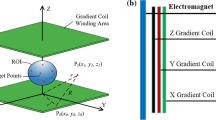Abstract
The design of a low-power gradient coil is of great importance for reducing the volume of low-field nuclear magnetic resonance (NMR) and improving its detection capability. In this paper, a gradient coil of low power without extra cooling device is optimized by solving the harmonic distribution of magnetic field at the field point and introducing the power consumption as the optimization objective function. Then, the gradient coil is designed by finite element method to solve the gradient field distribution in reverse. The simulation results show that the designed gradient coil possesses a very high linearity. Finally, the designed gradient coil is measured by Hall probe and NMR. The experimental results show that the designed gradient coils have the characteristics of strong gradient field, high linearity and low power. In conclusion, the gradient coils designed based on magnetic field harmonic analysis method are provided with low power consumption and excellent performance.








Similar content being viewed by others
Availability of Data and Materials
The datasets supporting the conclusions of this article are included within the article.
References
C.Z. Cooley, P.C. Mcdaniel, J.P. Stockmann et al., A portable scanner for magnetic resonance imaging of the brain. Nat. Biomed. Eng. 5, 1–11 (2020)
B. Mca, C. Rd, B. Pg, Evaluation of benchtop NMR Diffusion Ordered Spectroscopy for small molecule mixture analysis. Magn. Reson. Imaging 56, 103–109 (2019)
J. Wilkins, S. Miller, The use of adaptive algorithms for obtaining optimal electrical shimming in magnetic resonance imaging (MRI). IEEE Trans. Biomed. Eng. 36(2), 202–210 (1989)
R. Turner, Gradient coil design: a review of methods. Magn. Reson. Imaging 11(7), 903–920 (1993)
R. Turner, A target field approach to optimal coil design. J. Phys. D Appl. Phys. 19(8), L147 (1986)
L.K. Forbes, S. Crozier, A novel target-field method for finite-length magnetic resonance shim coils: I. Zonal shims. J. Phys. D Appl. Phys. 36(2), 68–80 (2003)
L.K. Forbes, S. Crozier, A novel target-field method for magnetic resonance shim coils: III. Shielded zonal and tesseral coils. J. Phys. D Appl. Phys. 36(2), 68–80 (2002)
W. Liu, D. Zu, X. Tang et al., Target-field method for MRI biplanar gradient coil design. J. Phys. D Appl. Phys. 40(15), 4418–4424 (2007)
L. Wen-Tao, Z. Dong-Lin, T. Xin, A novel approach to designing cylindrical-surface shim coils for a superconducting magnet of magnetic resonance imaging. Chin. Phys. 019(001), 563–574 (2010)
W. Liu, F. Casanova, B. Bernhard et al., An efficacious target-field approach to design shim coils for Halbach magnet of mobile NMR sensors. Appl. Magn. Reson. 42(1), 101–112 (2012)
T. Xia, Z. Miao, S. Chen, H. Wang, Y. Yao, Theory and development of biplanar active shim coils for a permanent NMR analyser. PLoS ONE 12(7), e0181552 (2017)
W.M. Garrett, Axially symmetric systems for generating and measuring magnetic fields. Part I. J. Appl. Phys. 22(9), 1091 (1951)
X. Yajie, Q. Chen et al., Shim coils design for Halbach magnet based on target field method. Appl. Magn. Reson. 46, 823–836 (2015)
Y. He, W. He et al., Design of biplanar shim coils for ultra-low field MRI. Int. J. Appl. Electromagnet. Mech. 58, 359–370 (2018)
S. Chen, T. Xia, Z. Miao et al., Active shimming method for a 2.13 MHz small-animal MRI magnet. Meas. Sci. Technol. 28(5), 055902 (2017)
A.E. Campbell-Washburn, R. Ramasawmy, M.C. Restivo et al., Opportunities in interventional and diagnostic imaging by using high-performance low-field-strength MRI. Radiology 293(2), 190452 (2019)
E. Förster, C.C. Fraenza, J. Küstner et al., Monitoring of engine oil aging by diffusion and low-field nuclear magnetic resonance relaxation. Measurement 137, 673–682 (2019)
P.M. Morse, H. Feshbach, Methods of Theoretical Physics (McGraw-Hill, New York, 1953)
S. Ding, The applications of green function theory to NMR. Chin. J. Chem. Phys. 06, 399–408 (1990)
R. Franoise, D.I. Hoult, Magnet field profiling: analysis and correcting coil design. Magn. Reson. Med. 1(1), 44–65 (2010)
J.H. Zhang, F.J. Zhang, Nonlinear maps preserving Lie products on factor von Neumann algebras. J. Hainan Trop. Ocean Univ. 429(1), 18–30 (2017)
Y.L. Zhang, Z.W. Liu, Orthogonality of Associated Legendre functions of different orders. Coll. Math. 2, 108–111 (2006)
K.Y. Kim, G.R. North, S.S. Shen, Optimal estimation of spherical harmonic components from a sample with spatially nonuniform covariance statistics. J. Clim. 9(3), 635–645 (1970)
D. Tomasi, Stream function optimization for gradient coil design. Magn. Reson. Med. 45, 5–12 (2001)
Z. Rui, X. Jing, F. Youyi, An optimized target-field method for MRI transverse biplanar gradient coil design. Meas. Sci. Technol. 22, 125505 (2011). (7 pp)
M. Holz, H. Weingartner, J. Magn. Reson. 92, 115–125 (1991)
M.I. Hrovat, C.G. Wade, J. Magn. Reson. 44, 62–75 (1981)
E. Fukushima, S.B.W. Roeder, Experimental Pulse NMR (Addison-Wesley, London, 1981), pp. 210–215
Acknowledgements
The authors sincerely thank Professor Zonghai Xie of Core Laboratory in the USA for his critical discussion during manuscript preparation.
Funding
Supported by National Key Scientific Instrument and Equipment Development Project of China (Grant no. 51627808), National Natural Science Foundation of China (Grant no. 52075098).
Author information
Authors and Affiliations
Contributions
The authors’ contributions are as follows: RL, HY and ZN were in charge of the whole trial; YW and ZH wrote the manuscript; ZH assisted with sampling and laboratory analyses.
Corresponding authors
Ethics declarations
Conflict of interest
The authors declare no competing financial interests.
Consent for publication
Not applicable.
Ethics approval and consent to participate
Not applicable.
Additional information
Publisher's Note
Springer Nature remains neutral with regard to jurisdictional claims in published maps and institutional affiliations.
Rights and permissions
About this article
Cite this article
Wu, YC., Hu, Z., Bao, C. et al. Design of High Linearity and Low Power Gradient Coil Based on Magnetic Field Harmonic Analysis Method. Appl Magn Reson 53, 1449–1465 (2022). https://doi.org/10.1007/s00723-022-01477-9
Received:
Revised:
Accepted:
Published:
Issue Date:
DOI: https://doi.org/10.1007/s00723-022-01477-9




